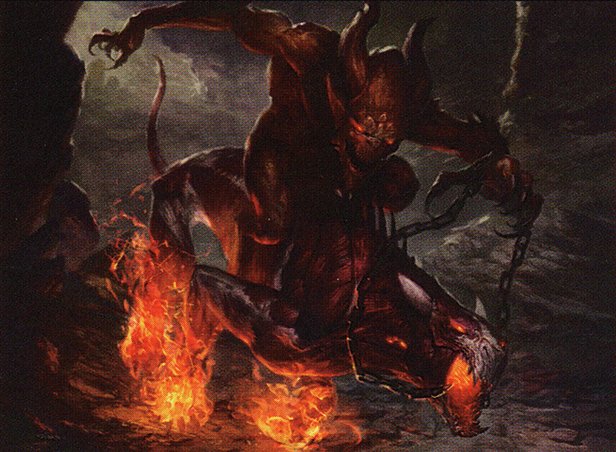 Art by Svetlin Velinov
Art by Svetlin VelinovThe experience® this cube aims to cultivate is defined by:
- Fast paced games, with lots of decision points and few board stalls.
- Good decks outperform good cards.
- Aggro, Midrange and Control all being able to 3:0.
- Good mana bases. Breaking singleton on Fetches and Shocks
- 70% power level. This is a Dragon's Rage Channeler format, not a Ragavan, Nimble Pilferer format.
- Narrow power band. Limiting losses/wins due to single card quality outliers à la retail limited or Vintage Cube.
- Colourless is the 6th colour.
Design Considerations to Achieve The experience®:
- Mana fixing lands are plentiful and good - I want drafters to be able to draft decks with reliable access to 2 colours on turn 1.
- Interaction - Lines up appropriately with threats. (More detailed thoughts on my design considerations here)
- Flexible cards are prioritized for inclusion - leading to more draft decisions and opportunity for play expression.
Notable Exclusions: - No planeswalkers - Planeswalkers provide too much impact and re-shape games in such a significant way that they are at odds with the “Good decks outperform good cards” goal.
- No infinite or instant-win combo - Combo seeks to ignore tempo and resource balancing that I find so enjoyable in most drafted magic.
Macro:
Aggro:- Primary:  , Secondary
, Secondary  ,
, ,
, , Tertiary:
, Tertiary:  ,
,
Midrange:- Primary:  , Secondary:
, Secondary:  ,
, ,
, ,
, , Tertiary:
, Tertiary: 
Control:- Primary:  ,
, , Secondary:
, Secondary:  ,
, , Tertiary:
, Tertiary: 
Micro:
Blink:- Primary:  , Secondary:
, Secondary:  , Tertiary:
, Tertiary: 
Spellslinger:- Primary: 
 , Secondary:
, Secondary:  Tertiary:
Tertiary: 
+1/+1 Counters:- Primary:  , Secondary:
, Secondary:  , Tertiary:
, Tertiary:  ,
,
Equipment:- Primary:  , Secondary:
, Secondary:  , Tertiary:
, Tertiary: 
Artifacts matter:- Primary:  , secondary
, secondary  ,
, , Tertiary:
, Tertiary: 
Aristocrats:- Primary:  , Secondary:
, Secondary:  ,
, , Tertiary:
, Tertiary: 
Lands - My current land balance of double fetches, triple shocks + a couple extras is carefully considered. So carefully in fact that I’ve written a whole article about nonbasic lands in cube. You can find it here if you want to dive deep on mana math for cube.
Front leaning creatures - One of the dials available to turn to keep a format aggressive and reduce board stalls is to provide creatures with toughness lower than their power. This results in more boardstates where it’s advantageous to attack, as you’re more likely to trade.
Few DFCs - While DFCs add modality and options which can be beneficial to an environment, I’ve chosen to limit this affect as the added complexity cost while drafting and playing typically isn’t worth it to me.
Removal baseline - at instant speed 1MV spells should deal with 2 toughness or MV, 2MV spells should deal with 3 toughness, 3MV spells should deal with anything. Improving on these rates should require additional cost or downsides. E.g. Feed the Swarm has 2 downsides: it’s sorcery speed & it causes life loss.
The density of removal in the cube is tuned so that players have access to enough interaction, but that the quality doesn’t invalidate playing larger threats. Committing 4-5 mana and a full turn to a large creature only to have it Swords to Plowshares’d is not gameplay I’m interested in.
Similarly, the threats need to line up with removal, typically cards in this cube at 4+ MV will have high enough toughness that they don’t fold to 1-2MV removal without providing some upside.
Occasionals:
Alongside the main cube, I curate a second list of “occasional cards” . 24 cards are selected at random from this list before drafting the Agile cube, and 1 added to each booster pack. These cards aim to provide some variety in the cube, allowing for inclusion of more narrow cards without taking up cube real estate.
Occasional cards are added to the packs on top of the typical draft amount, increasing pack size and avoiding replacing important cards. The beauty of this system is that people have the opportunity to draft with some variety without losing the cohesive baseline of a fully drafted cube.
x packs of y (draft pool)(cards drafted)
| Players | Primary Method | Alternate Method |
|---|---|---|
| 8 | 3 packs of 16 (48)(384) | |
| 6 | 4 packs of 16, burn last 4 (48)(384) | 4 packs of 12 (48)(288) |
| 4 | 6 packs of 16, burn last 8 (48)(384) | 5 packs of 9 (45)(180) or 16 pack of 15 grid |
| 2 | Hausmann draft or 100 card Winston draft or Minneapolis draft | 18 packs of 9 grid |
Use the below links to filter the cube by wedge or shard before exporting to draft with lower player count without needing to burn.
Bant, Esper, Grixis, Jund, Naya
Abzan, Jeskai, Sultai, Mardu, Temur
Tagging Threats & Removal:
Inspired by lucky paper radio episode 127, I've decided to rank the threats in my cube by resilience against removal. Using a 1-4 scale from "Baneslayer" to "Mulldrifter". Cards on this scale have been tagged BM1 through BM4 depending on the below subjective criteria.
Click on the headings to be taken to the corresponding filter of the cube.
BM1:
"Baneslayers".
A BM1 card will need more than the turn it's played to utilise its intrinsic value.
Ward - 1 Life.
Examples:
Usher of the Fallen / Woodland Wanderer
BM2:
Some value against removal.
Value typically added before sorcery speed interaction. e.g. luminarch aspirant / Feldon, Ronom Excavator / Soulherder.
Cards which can be sequenced to provide immediate separate value e.g. young Pyromancer -> Shock on turn 3.
Flashable blockers
Lower impact adventures
Slightly punishing to remove: Ward  or 2-3 life.
or 2-3 life.
BM3:
Substantial value against removal (Mulldrifters of all sorts)
Value typically added before instant speed interaction.
Higher impact adventures
Harder to remove: Ward  , 4+ life, higher costed hexproof or indestructible
, 4+ life, higher costed hexproof or indestructible
BM4:
Resistant to removal or actively bad to remove (great death triggers, trivially recurred threats)
Hardest to remove: Ward  + / free or low costed hexproof or indestructible
+ / free or low costed hexproof or indestructible
Note:
Cards which remove cards from graveyards (like Scavenging Ooze) are ranked as BM1 here. In a cube with much stronger graveyard support and/or reanimator I'd bump these up to BM2.
Removal
Similarly, I've decided to rank the removal in my cube by effectiveness and condition requirement. Using some made-up buckets, cards on this scale have been tagged depending on the below subjective criteria.
Click on the headings to be taken to the corresponding filter of the cube.
RU - Unconditional Removal:
Removes a creature all the time (excl. hexproof/protection etc.)
e.g. murder / vindicate / Vraska's Contempt
RD - Removal with downside:
Removes a thing all the time, but has a downside.
e.g. fateful absence / pacifism / pongify
Opponent has control over the downside element.
RA - Removal with additional costs:
e.g. Ulcerate / Bone Shards / Lightning Axe
You have control over this additional cost as a downside.
RT - Removal that can be undone (temporary):
Removes unconditionally but can be rolled back by Opp.
e.g. Oblivion Ring / Skyclave apparition / Dungeon Geists
RS- Soft removal:
Doesn't actually remove the threat, but does temporarily neutralise it.
e.g. Flickerwisp / unsummon / Earthshaker Khenra
RCM - Conditional - Main Attributes:
MV, power, toughness, important keywords
e.g. Fatal Push / Shock / Plummet
RCP - Conditional - Parallel Attributes:
Colour, creature type, etc.
e.g. Terror / Walk the Plank
RCB - Conditional - Board State:
Fight spells, attacking/blocking, edicts, combat tricks, Flashable blockers with 2+ power.
e.g. Ram Through / Settle the Wreckage / Diabolic Edict / Bannerhide Krushok / Cathar Commando
Lots of interesting cards in the set for retail, but few that fit the cube's goals due to the density of 2 & 3 colour cards and focus on high MV cards designed for slow games.
❌ Stasis Snare
✅ Static Snare - Similar swap for slightly less colour intensive card. Lower floor and higher ceiling that can be manufactured by the attacker makes this a compelling include in aggressive decks as well as controlling ones.
❌ Fertile Ground - No longer particularly exciting without the sometimes treat of untapping it with Arbor Elf
✅ Herd Heirloom - Another similar swap with downside of being only useable with creature spells but providing a built-in reward for your big creatures. Due to the minimal number of 4+ power creatures in the cube this won't always be live and will be improved alongside ways to modify creatures.
❌ Heartfire Immolator - Out as 2/2 prowess with slight upside for the inclusion of a 2/2 prowess with huge upside.
✅ Cori-Steel Cutter - Pretty significant power level increase. I like rewarding double-spelling here and this is once hell of a good card that slots well into multiple archetypes. RW aggro, RU tempo, Rx Artifacts will all love this. T2 Cutter + one of the 7 zero mana artifacts should be pretty excellent!
❌ Seeker of the Way
✅ Voice of Victory - I want more options to signal/enable both the go-wide style of aggro, and also provide fodder for the sacrifice decks that aren't just recursive black creatures. Voice of Victory seems perfect in this role, swinging for big damage with Warleader's Call and feeding Goblin Bombardment excellently.
❌ Vengeful Rebel - hasn't been exciting or seen play in forever. There are enough fetches here that this should acts as a mini Chupacabra on a better body, but in reality people just don't play it.
✅ Avenger of the Fallen - In for similar reasons as Voice of Victory, although I am worried about including a black 3-drop with 4 toughness, something I'd ideally like to reserve to only green. If this had 3 toughness I'd be excited to run it for a long time, as it stands it's on the watchlist for cutting.

